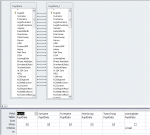Hi,
i have SQL like here:
so i have more than 16 fields and this is working. The restriction of joins in Access 16 is not working here.
Why ?
What i am not understanding?
Best,
Jacek
i have SQL like here:
Code:
SELECT DISTINCT *
FROM tblVolumes AS t2 LEFT JOIN qryIm_SourceVolumes AS t1 ON (t2.PercentSnapshotSpace = t1.PercentSnapshotSpace or (t2.PercentSnapshotSpace is Null AND t1.PercentSnapshotSpace is Null)) AND (t2.FilesystemType = t1.FilesystemType or (t2.FilesystemType is Null AND t1.FilesystemType is Null)) AND (t2.DiskNumber = t1.DiskNumber or (t2.DiskNumber is Null AND t1.DiskNumber is Null)) AND (t2.VolumeNameIDFK = t1.VolumeNameIDFK or (t2.VolumeNameIDFK is Null AND t1.VolumeNameIDFK is Null)) AND (t2.PhysicalDiskModelIDFK = t1.PhysicalDiskModelIDFK or (t2.PhysicalDiskModelIDFK is Null AND t1.PhysicalDiskModelIDFK is Null)) AND (t2.TierID = t1.TierID or (t2.TierID is Null AND t1.TierID is Null)) AND (t2.Ordinal = t1.Ordinal or (t2.Ordinal is Null AND t1.Ordinal is Null)) AND (t2.EnvironmentID = t1.EnvironmentID or (t2.EnvironmentID is Null AND t1.EnvironmentID is Null)) AND (t2.ShareMode = t1.ShareMode or (t2.ShareMode is Null AND t1.ShareMode is Null)) AND (t2.SubjectComponent = t1.SubjectComponent or (t2.SubjectComponent is Null AND t1.SubjectComponent is Null)) AND (t2.FormatCommand = t1.FormatCommand or (t2.FormatCommand is Null AND t1.FormatCommand is Null)) AND (t2.Description = t1.Description or (t2.Description is Null AND t1.Description is Null)) AND (t2.Function = t1.Function or (t2.Function is Null AND t1.Function is Null)) AND (t2.Caching = t1.Caching or (t2.Caching is Null AND t1.Caching is Null)) AND (t2.writeAcceleratorEnabled = t1.writeAcceleratorEnabled or (t2.writeAcceleratorEnabled is Null AND t1.writeAcceleratorEnabled is Null)) AND (t2.Caching = t1.Caching or (t2.Caching is Null AND t1.Caching is Null))
WHERE (((t1.Ordinal) Is Null) AND ((t1.EnvironmentID) Is Null) AND ((t1.TierID) Is Null) AND ((t1.PhysicalDiskModelIDFK) Is Null) AND ((t1.VolumeNameIDFK) Is Null) AND ((t1.DiskNumber) Is Null) AND ((t1.FileSystemType) Is Null) AND ((t1.PercentSnapshotSpace) Is Null) AND ((t1.ShareMode) Is Null) AND ((t1.SubjectComponent) Is Null) AND ((t1.FormatCommand) Is Null) AND ((t1.Description) Is Null) AND ((t1.Function) Is Null) AND ((t1.Caching) Is Null) AND ((t1.writeAcceleratorEnabled) Is Null));so i have more than 16 fields and this is working. The restriction of joins in Access 16 is not working here.
Why ?
What i am not understanding?
Best,
Jacek



